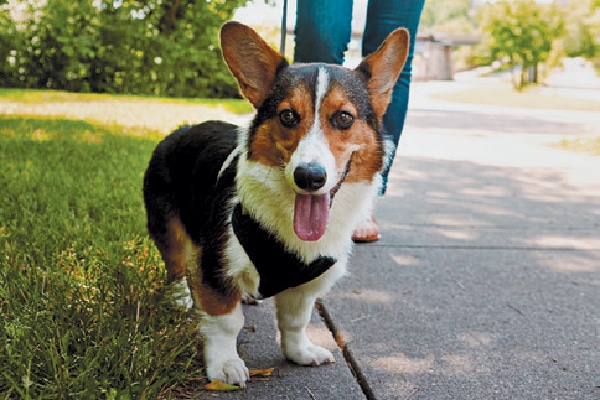Contrary to popular (but flawed) belief, dogs don’t pull on the leash because they want to be pack leader, top dog or be the alpha over humans. There is a much simpler explanation that doesn’t give credence to the misguided paranoia that dogs are on a quest for world domination! Dogs just love to be outside, and the walk is a stimulating and exciting part of their day. The desire to get ahead and discover the world around them is very strong, and a leash impedes that discovery. Here’s how to stop dog pulling during walks.
Why dog have issues walking on a leash in the first place

Why does dog pulling happen in the first place? Why do dogs have such issues going out for walks? Photography ©gradyreese | Getty Images.
Let’s face it: People don’t make ideal walking partners for most dogs since a dog’s natural and comfortable walking pace is much faster than a human’s.
Having to walk calmly by a person’s side when the dog wants to run and investigate requires a degree of impulse control that can be difficult for some dogs. You might experience what it’s like to impede your gait when you walk next to a toddler, and if you have things to do and places to go, you might get a little frustrated as well.
Safe and humane gear to stop dog pulling while on a walk
Instead of thinking how annoying your dog’s pulling is for you, consider how frustrating it must be for your dog to lose the ability to act naturally because she is “tied” to you. That being said, all dogs need to be taught how to walk on a leash in a positive way without pain or discomfort so that a walk is safe and enjoyable for everyone.
If you’re overpowered by your dog’s pulling and cannot start the teaching process for fear of being pulled over, there are humane equipment solutions to help modify pulling while you teach your dog to walk appropriately.
A chest-led harness, like the Positively No-Pull Harness, is a perfect training aid, as it takes pressure off a dog’s sensitive neck by distributing the pressure more evenly around the body. When the leash is attached to one of two rings located on the chest strap, (the point of connection on the chest is essentially your dog’s center of gravity), the harness will turn her body slightly around rather than allowing her to move forward when she pulls. I recommend this kind of harness for anyone who needs extra help walking their dog, as safety must come first.
Other tips to stop your dog pulling on his leash
Pulling on leash is often successful for the dog because people inadvertently reinforce it by allowing their dogs to get to where they want to go when they pull. Change this picture by changing the consequence for your dog. When she pulls, immediately stop and stand completely still until the leash relaxes, either by your dog taking a step back or turning around to give you focus. When the leash is nicely relaxed, proceed on your walk. Repeat as necessary.
If you find this technique too slow, try the reverse direction method. When your dog pulls, say, “Let’s go,” as you turn away from her and walk off in the other direction, without yanking her on the leash. Avoid yanking by motivating your dog to follow you with an excited voice to get her attention.
When she follows you and the leash is relaxed, turn back and continue on your way. It might take a few turns, but your vocal cues and body language will be clear: Pulling won’t be reinforced with forward movement, but walking calmly by your side or even slightly to the side in front of you on a loose leash will get your dog to where she wants to go. Also reinforce your dog’s decision to walk close to you by giving a motivating reward when she is by your side.
Stop dog pulling by varying your behavior, too
Once your dog is listening to you more, vary the picture by becoming unpredictable yourself. This means your dog has to listen to you at all times because she never knows when you’re going to turn or where you’re going to go next.
Instead of turning away from her, reverse the direction by turning toward her, turn in a circle or do a figure eight. Any of these variations will get your dog’s attention. Praise her for complying, because the better you make her feel walking close to you, the more she will choose to do so.
Tell us: How do you stop dog pulling?
Thumbnail: Photography ©Westend6 | Getty Images.
Editor’s note: This article first appeared in Dogster magazine. Have you seen the new Dogster print magazine in stores? Or in the waiting room of your vet’s office? Subscribe now to get Dogster magazine delivered straight to you!
Victoria Stilwell, dog trainer, TV personality, author and public speaker, is best known as the star of the TV series It’s Me or the Dog, through which she reaches audiences in more than 100 countries. Appearing frequently in the media, she’s widely recognized as a leader in the field of animal behavior, is editor-in-chief of positively.com, CEO of the VSPDT network of licensed trainers and the founder of the Victoria Stilwell Academy for Dog Training & Behavior — the leader in dog trainer education. Connect with her on Facebook or Twitter at @victorias.
Read more from Dogster Magazine on Dogster.com:
- 5 Dog Supplements You Must Know About
- Could Grain-Free Diets Cause Issues for Dogs?
- What to Feed a Dog With Diarrhea or Other Stomach Issues
The post How to Stop Dog Pulling and Have a Better Walk appeared first on Dogster.
No comments:
Post a Comment